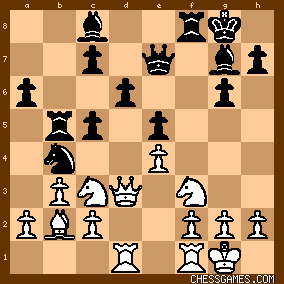Mar-09-11
 | | Pawn and Two: After 10 rounds at London 1932, Alekhine led with 8 1/2, followed by Sultan Khan - 7 1/2, and Flohr & Kashdan - 7. In the 11th and final round, Flohr beat Koltanowski, Kashdan drew with Winter, and Sultan Khan lost to Maroczy. With his last round draw against Thomas, Alekhine finished in 1st place, a full point ahead of Flohr, and 1 1/2 points ahead of Kashdan and Sultan Khan. However, the tournament finish could have been a closer. In the final round, in a game of 53 moves, Sultan Khan lost a difficult ending to Maroczy. At some points in this ending, Khan had held a small advantage. In the Thomas-Alekhine game, Thomas had a good opening, and at move 10, Fritz preferred: 10.dxe5 fxe5 (.88) (21 ply) 11.Be3 Nf6 (.78) (21 ply) 12.0-0-0 Bb7 13.Qe2 Qe7. After 10.dxe5, 10...dxe5? is inferior: (1.14) (21 ply) 11.Qe2 Bb4 12.Bd2 Ne7 13.Rd1 Qd6 14.Na4 Bxd2+ 15.Rxd2 Qa3 16.0-0 0-0. At move 15, Fritz indicates an advantage for White: (.66) (22 ply) 15.Nd2 Nc6 16.f4 Nb4 17.Qc3 Qe7 18.a3 Nc6. Instead, White played 15.Qc3?, and after 15...Nc6 16.Qc4. Black had a very small edge: (-.32) (21 ply) 16...a5 17 Rfe1 Qf7 18.Qxf7+ Kxf7 19.Ng5+ Kf8 20.f4 h6 21.Nf3 exf4 22.Bxg7+ Kxg7 23.Nxf4, (-.17) (21 ply) 23...Rf8. Instead of 16...a5, Alekhine played 16...Rb4, and at move 19, Fritz shows a small edge for White with: (.28) (21 ply) 19.Nc3 Ra5 20.Bb2 Nb4 21.Qe2 Nxa2 22.Qc4+ Qe6 23.Qxe6+ Bxe6 24.Ra1 Nxc3 25.Rxa5 Nxe4, (.26) (21 ply) 26.Re1 Nf6 27.Rxa6. After 19.Bb2, the advantage again shifted to Black: (-.37) (21 ply) 19...Rb8! 20.Nc3 Nb4 21.Qd2, (-.39) (20 ply) 21...Qg4. Alekhine's 19...Qe7? was an error, and after 20.Nc3! Nb4, Thomas was in position to win material.: 
click for larger viewThomas could have won material with the move 21.Qd2!. It must be admitted the resulting ending would have been extremely difficult for both sides, but White does obtain some winning chances, as the following analysis shows: (.99) (22 ply) 21.Qd2! Rxf3, (if 21...Be6 22.Nxb5 axb5 23.Qe2 appears very favorable for White, but further analysis is needed), (.85) (25 ply) 21...Rxf3 22.Nxb5 axb5 23.gxf3 Bh3, (.73) (26 ply) 24.a4 Nxc2 25.axb5, (.71) (25 ply) 25...Nd4 26.Bxd4 exd4, (.79) (25 ply) 27.Qf4 Be5 28.Qh6 Bxf1 29.Rxf1, (1.26) (27 ply) 29...Bg7 30.Qf4 Be5 31.Qg4 Qf7 32.f4, (1.82) (27 ply) 32...Bxf4 33.Ra1 h5 34.Qh3 Qe8 35.Ra7 d5 36.exd5 Qe1+ 37.Kg2 Qe4+ 38.Qf3 Qxf3+ 39.Kxf3 Bxh2, and White wins with: 40.d6 Bxd6 41.Ra6 Be5 42.Rxg6+. Or, if (2.01) (27 ply) 32...Qxf4 33.Qxf4 Bxf4 34.Ra1 d5 35.exd5 Kf7 36.Kg2 Kf6 37.Ra6+ Kf5 38.d6 cxd6 39.b6 d3, and White wins with: (3.52) (23 ply) 40.b7 d2 41.Ra1 d5 42.Kf3 Bxh2 43.Ke2 Ke6 44.Kxd2 h5 45.Ra8. At move 25, Black could also try: (.86) (25 ply) 25...h5 26.Ra1 Kh7 27.Ra8 Qf7 28.Qd3 Nd4 29.Bxd4 exd4 30.f4 Bxf1 31.Kxf1 Qxf4, (2.73) (26 ply) 32.Ra7 Qc1+ 33.Ke2 Qf4 34.h3 Qe5 35.Kf1 c4 36.bxc4 Qc5 37.Ra6 Be5 38.Rc6 Qa7 39.h4, or 32...d5 33.exd5 Qxh2 34.Qf3 Kh6 35.d6 Qxd6 36.Qf7 Qh2 37.Rxc7, with White winning in both of these variations. No doubt improvements can be found for both sides in these long variations. However, had Thomas found the move 21.Qd2!, he could have won material, and obtained winning chances. The resulting difficult ending would have caused terrific tension for the players, but it would have been wonderful to watch. |





